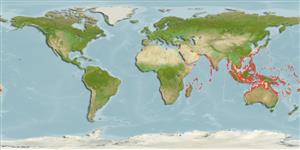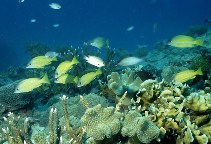Lutjanus quinquelineatus (Bloch, 1790)
Five-lined snapper
Add your observation in Fish Watcher
| Native range | All suitable habitat | Point map | Year 2050 |

|
| This map was computer-generated and has not yet been reviewed. |
| Lutjanus quinquelineatus AquaMaps Data sources: GBIF OBIS |
Upload your photos and videos
Pictures | Videos | Google imageLutjanus quinquelineatus
Picture by Cook, D.C.
Pictures | Videos | Google imageLutjanus quinquelineatus
Picture by Cook, D.C.
Classification / Names Nombres comunes | Sinónimos | Catalog of Fishes(Género, Especie) | ITIS | CoL | WoRMS | Cloffa
> Eupercaria/misc (Various families in series Eupercaria) > Lutjanidae (Snappers) > Lutjaninae
Etymology: Lutjanus: Malay, ikan lutjan, name of a fish.
More on author: Bloch.
Etymology: Lutjanus: Malay, ikan lutjan, name of a fish.
More on author: Bloch.
Environment: milieu / climate zone / depth range / distribution range Ecología
marino asociado a arrecife; rango de profundidad 2 - 40 m (Ref. 9710). Tropical; 35°N - 37°S, 42°E - 176°W (Ref. 55)
Distribución Países | Áreas FAO | Ecosistemas | Ocurrencias, apariciones | Point map | Introducciones | Faunafri
Indo-West Pacific: Persian Gulf and the Gulf of Oman to Fiji, north to southern Japan. This species has been referred to as Lutjanus spilurus.
Tamaño / Peso / Age
Maturity: Lm ? range ? - ? cm
Max length : 38.0 cm TL macho / no sexado; (Ref. 55); common length : 30.0 cm TL macho / no sexado; (Ref. 5450); edad máxima reportada: 31 años (Ref. 34051)
Max length : 38.0 cm TL macho / no sexado; (Ref. 55); common length : 30.0 cm TL macho / no sexado; (Ref. 5450); edad máxima reportada: 31 años (Ref. 34051)
Short description Claves de identificación | Morfología | Morfometría
Espinas dorsales (total) : 10; Radios blandos dorsales (total) : 13 - 15; Espinas anales: 3; Radios blandos anales: 8. Dorsal profile of head steeply sloped. Preorbital width usually less than eye diameter. Preopercular notch and knob well developed. Scale rows on back rising obliquely above lateral line. Generally bright yellow, including fins, with a series of blue stripes on the side. A round black spot, about the size of the eye or larger, is below the anterior most soft dorsal rays, touching the lateral line but mostly above it (Ref. 469). Body depth 2.3-2.9 in SL (Ref. 90102).
Adults inhabit sheltered lagoons and exposed, outer slope coral reefs. Frequently encountered in large aggregations including 100 or more individuals at moderate depths, usually in 30-40m, like in some Pacific locations (Ref. 48635). Juveniles solitary and shallow in protected bays with algae and rubble substrates. They feed mainly on fishes and crustaceans (Ref. 4533).
Life cycle and mating behavior Madurez | Reproducción | Puesta | Huevos | Fecundidad | Larva
Main reference
Upload your references | Referencias | Coordinador | Colaboradores
Allen, G.R., 1985. FAO Species Catalogue. Vol. 6. Snappers of the world. An annotated and illustrated catalogue of lutjanid species known to date. FAO Fish. Synop. 125(6):208 p. Rome: FAO. (Ref. 55)
IUCN Red List Status (Ref. 130435: Version 2024-2)
Least Concern (LC) ; Date assessed: 05 March 2015
CITES
Not Evaluated
Threat to humans
Harmless
Human uses
Pesquerías: comercial; pesca deportiva: si; Acuario: Comercial
FAO - pesquerías: landings; Publication: search | FishSource | Sea Around Us
Más información
Trophic ecology
componentes alimenticios
Composición de la dieta
consumo de alimento
Food rations
Despredadores
componentes alimenticios
Composición de la dieta
consumo de alimento
Food rations
Despredadores
Population dynamics
Coeficiente del crecimiento para
Max. ages / sizes
Length-weight rel.
Length-length rel.
Length-frequencies
Mass conversion
Reclutamiento
Abundancia
Coeficiente del crecimiento para
Max. ages / sizes
Length-weight rel.
Length-length rel.
Length-frequencies
Mass conversion
Reclutamiento
Abundancia
Life cycle
Reproducción
Madurez
Maturity/Gills rel.
Fecundidad
Puesta
Spawning aggregations
Huevos
Egg development
Larva
Dinámica larvaria
Reproducción
Madurez
Maturity/Gills rel.
Fecundidad
Puesta
Spawning aggregations
Huevos
Egg development
Larva
Dinámica larvaria
Physiology
Body composition
Nutrients
Consumo del oxígeno
Tipo de natación
Velocidad de natación
Visual pigments
Fish sound
Diseases & Parasites
Toxicity (LC50s)
Body composition
Nutrients
Consumo del oxígeno
Tipo de natación
Velocidad de natación
Visual pigments
Fish sound
Diseases & Parasites
Toxicity (LC50s)
Genetics
Genética
Heterozygosity
heritabilidad
Genética
Heterozygosity
heritabilidad
Human related
Aquaculture systems
Perfiles de acuicultura
Razas
Ciguatera cases
Stamps, coins, misc.
Aquaculture systems
Perfiles de acuicultura
Razas
Ciguatera cases
Stamps, coins, misc.
Herramientas
Bio-Quiz | E-book | Guía de campo | Claves de identificación | Asistente para frecuencias de tallas | Herramienta de ciclo de vida | Mapa de puntos | Classification Tree
| Catch-MSY |
Special reports
Download XML
Fuentes de Internet
AFORO (otoliths) | Aquatic Commons | BHL | Cloffa | BOLDSystems | Websites from users | Check FishWatcher | CISTI | Catalog of Fishes: Género, Especie | DiscoverLife | ECOTOX | FAO - pesquerías: landings; Publication: search | Faunafri | Fishipedia | Fishtrace | GenBank: genome, nucleotide | GloBI | Google Books | Google Scholar | Google | IGFA World Record | MitoFish | Bases de datos nacionales | Otolith Atlas of Taiwan Fishes | PubMed | Reef Life Survey | Socotra Atlas | Árbol de la vida | Wikipedia: Go, búsqueda | World Records Freshwater Fishing | Expediente Zoológico
Estimates based on models
Preferred temperature (Ref. 123201): 24.7 - 29.1, mean 28.2 °C (based on 1068 cells).
Phylogenetic diversity index (Ref. 82804): PD50 = 0.5000 [Uniqueness, from 0.5 = low to 2.0 = high].
Bayesian length-weight: a=0.01349 (0.00886 - 0.02054), b=2.98 (2.86 - 3.10), in cm total length, based on LWR estimates for this species & Genus-body shape (Ref. 93245).
Nivel trófico (Ref. 69278): 3.7 ±0.2 se; based on diet studies.
Resiliencia (Ref. 120179): Bajo, población duplicada en un tiempo mínimo de 4.5-14 años (tmax=31; k=0.22-0.37; Fec>160,000).
Prior r = 0.33, 95% CL = 0.22 - 0.49, Based on 1 data-limited stock assessment.
Fishing Vulnerability (Ref. 59153): Low to moderate vulnerability (34 of 100).
Climate Vulnerability (Ref. 125649): High vulnerability (56 of 100).
Nutrients (Ref. 124155): Calcium = 39.6 [26.6, 57.1] mg/100g; Iron = 0.348 [0.224, 0.529] mg/100g; Protein = 18.4 [16.9, 19.7] %; Omega3 = 0.128 [0.090, 0.177] g/100g; Selenium = 52 [36, 76] μg/100g; VitaminA = 163 [30, 588] μg/100g; Zinc = 0.508 [0.408, 0.695] mg/100g (wet weight);




